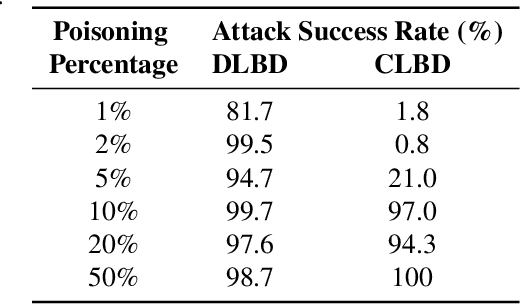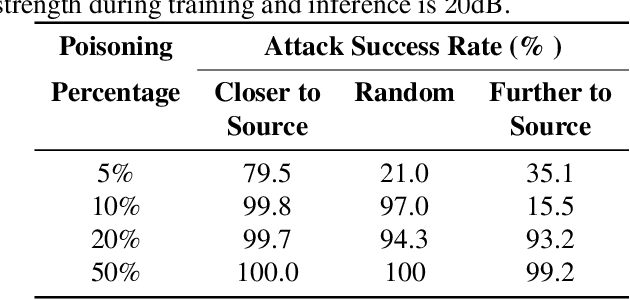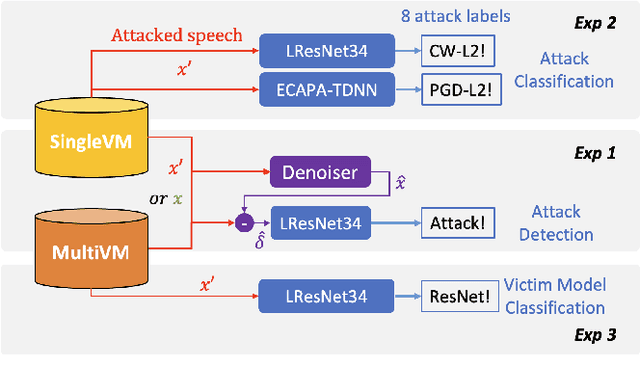Thomas Thebaud
LIUM
Rhythm Features for Speaker Identification
Jun 07, 2025Abstract:While deep learning models have demonstrated robust performance in speaker recognition tasks, they primarily rely on low-level audio features learned empirically from spectrograms or raw waveforms. However, prior work has indicated that idiosyncratic speaking styles heavily influence the temporal structure of linguistic units in speech signals (rhythm). This makes rhythm a strong yet largely overlooked candidate for a speech identity feature. In this paper, we test this hypothesis by applying deep learning methods to perform text-independent speaker identification from rhythm features. Our findings support the usefulness of rhythmic information for speaker recognition tasks but also suggest that high intra-subject variability in ad-hoc speech can degrade its effectiveness.
SoloSpeech: Enhancing Intelligibility and Quality in Target Speech Extraction through a Cascaded Generative Pipeline
May 25, 2025Abstract:Target Speech Extraction (TSE) aims to isolate a target speaker's voice from a mixture of multiple speakers by leveraging speaker-specific cues, typically provided as auxiliary audio (a.k.a. cue audio). Although recent advancements in TSE have primarily employed discriminative models that offer high perceptual quality, these models often introduce unwanted artifacts, reduce naturalness, and are sensitive to discrepancies between training and testing environments. On the other hand, generative models for TSE lag in perceptual quality and intelligibility. To address these challenges, we present SoloSpeech, a novel cascaded generative pipeline that integrates compression, extraction, reconstruction, and correction processes. SoloSpeech features a speaker-embedding-free target extractor that utilizes conditional information from the cue audio's latent space, aligning it with the mixture audio's latent space to prevent mismatches. Evaluated on the widely-used Libri2Mix dataset, SoloSpeech achieves the new state-of-the-art intelligibility and quality in target speech extraction and speech separation tasks while demonstrating exceptional generalization on out-of-domain data and real-world scenarios.
Vox-Profile: A Speech Foundation Model Benchmark for Characterizing Diverse Speaker and Speech Traits
May 20, 2025Abstract:We introduce Vox-Profile, a comprehensive benchmark to characterize rich speaker and speech traits using speech foundation models. Unlike existing works that focus on a single dimension of speaker traits, Vox-Profile provides holistic and multi-dimensional profiles that reflect both static speaker traits (e.g., age, sex, accent) and dynamic speech properties (e.g., emotion, speech flow). This benchmark is grounded in speech science and linguistics, developed with domain experts to accurately index speaker and speech characteristics. We report benchmark experiments using over 15 publicly available speech datasets and several widely used speech foundation models that target various static and dynamic speaker and speech properties. In addition to benchmark experiments, we showcase several downstream applications supported by Vox-Profile. First, we show that Vox-Profile can augment existing speech recognition datasets to analyze ASR performance variability. Vox-Profile is also used as a tool to evaluate the performance of speech generation systems. Finally, we assess the quality of our automated profiles through comparison with human evaluation and show convergent validity. Vox-Profile is publicly available at: https://github.com/tiantiaf0627/vox-profile-release.
Demographic Attributes Prediction from Speech Using WavLM Embeddings
Feb 17, 2025Abstract:This paper introduces a general classifier based on WavLM features, to infer demographic characteristics, such as age, gender, native language, education, and country, from speech. Demographic feature prediction plays a crucial role in applications like language learning, accessibility, and digital forensics, enabling more personalized and inclusive technologies. Leveraging pretrained models for embedding extraction, the proposed framework identifies key acoustic and linguistic fea-tures associated with demographic attributes, achieving a Mean Absolute Error (MAE) of 4.94 for age prediction and over 99.81% accuracy for gender classification across various datasets. Our system improves upon existing models by up to relative 30% in MAE and up to relative 10% in accuracy and F1 scores across tasks, leveraging a diverse range of datasets and large pretrained models to ensure robustness and generalizability. This study offers new insights into speaker diversity and provides a strong foundation for future research in speech-based demographic profiling.
Detecting Neurodegenerative Diseases using Frame-Level Handwriting Embeddings
Feb 10, 2025Abstract:In this study, we explored the use of spectrograms to represent handwriting signals for assessing neurodegenerative diseases, including 42 healthy controls (CTL), 35 subjects with Parkinson's Disease (PD), 21 with Alzheimer's Disease (AD), and 15 with Parkinson's Disease Mimics (PDM). We applied CNN and CNN-BLSTM models for binary classification using both multi-channel fixed-size and frame-based spectrograms. Our results showed that handwriting tasks and spectrogram channel combinations significantly impacted classification performance. The highest F1-score (89.8%) was achieved for AD vs. CTL, while PD vs. CTL reached 74.5%, and PD vs. PDM scored 77.97%. CNN consistently outperformed CNN-BLSTM. Different sliding window lengths were tested for constructing frame-based spectrograms. A 1-second window worked best for AD, longer windows improved PD classification, and window length had little effect on PD vs. PDM.
CA-SSLR: Condition-Aware Self-Supervised Learning Representation for Generalized Speech Processing
Dec 05, 2024Abstract:We introduce Condition-Aware Self-Supervised Learning Representation (CA-SSLR), a generalist conditioning model broadly applicable to various speech-processing tasks. Compared to standard fine-tuning methods that optimize for downstream models, CA-SSLR integrates language and speaker embeddings from earlier layers, making the SSL model aware of the current language and speaker context. This approach reduces the reliance on input audio features while preserving the integrity of the base SSLR. CA-SSLR improves the model's capabilities and demonstrates its generality on unseen tasks with minimal task-specific tuning. Our method employs linear modulation to dynamically adjust internal representations, enabling fine-grained adaptability without significantly altering the original model behavior. Experiments show that CA-SSLR reduces the number of trainable parameters, mitigates overfitting, and excels in under-resourced and unseen tasks. Specifically, CA-SSLR achieves a 10% relative reduction in LID errors, a 37% improvement in ASR CER on the ML-SUPERB benchmark, and a 27% decrease in SV EER on VoxCeleb-1, demonstrating its effectiveness.
Clean Label Attacks against SLU Systems
Sep 13, 2024



Abstract:Poisoning backdoor attacks involve an adversary manipulating the training data to induce certain behaviors in the victim model by inserting a trigger in the signal at inference time. We adapted clean label backdoor (CLBD)-data poisoning attacks, which do not modify the training labels, on state-of-the-art speech recognition models that support/perform a Spoken Language Understanding task, achieving 99.8% attack success rate by poisoning 10% of the training data. We analyzed how varying the signal-strength of the poison, percent of samples poisoned, and choice of trigger impact the attack. We also found that CLBD attacks are most successful when applied to training samples that are inherently hard for a proxy model. Using this strategy, we achieved an attack success rate of 99.3% by poisoning a meager 1.5% of the training data. Finally, we applied two previously developed defenses against gradient-based attacks, and found that they attain mixed success against poisoning.
Supervised and Unsupervised Alignments for Spoofing Behavioral Biometrics
Aug 14, 2024Abstract:Biometric recognition systems are security systems based on intrinsic properties of their users, usually encoded in high dimension representations called embeddings, which potential theft would represent a greater threat than a temporary password or a replaceable key. To study the threat of embedding theft, we perform spoofing attacks on two behavioral biometric systems (an automatic speaker verification system and a handwritten digit analysis system) using a set of alignment techniques. Biometric recognition systems based on embeddings work in two phases: enrollment - where embeddings are collected and stored - then authentication - when new embeddings are compared to the stored ones -.The threat of stolen enrollment embeddings has been explored by the template reconstruction attack literature: reconstructing the original data to spoof an authentication system is doable with black-box access to their encoder. In this document, we explore the options available to perform template reconstruction attacks without any access to the encoder. To perform those attacks, we suppose general rules over the distribution of embeddings across encoders and use supervised and unsupervised algorithms to align an unlabeled set of embeddings with a set from a known encoder. The use of an alignment algorithm from the unsupervised translation literature gives promising results on spoofing two behavioral biometric systems.
Noise-robust Speech Separation with Fast Generative Correction
Jun 11, 2024Abstract:Speech separation, the task of isolating multiple speech sources from a mixed audio signal, remains challenging in noisy environments. In this paper, we propose a generative correction method to enhance the output of a discriminative separator. By leveraging a generative corrector based on a diffusion model, we refine the separation process for single-channel mixture speech by removing noises and perceptually unnatural distortions. Furthermore, we optimize the generative model using a predictive loss to streamline the diffusion model's reverse process into a single step and rectify any associated errors by the reverse process. Our method achieves state-of-the-art performance on the in-domain Libri2Mix noisy dataset, and out-of-domain WSJ with a variety of noises, improving SI-SNR by 22-35% relative to SepFormer, demonstrating robustness and strong generalization capabilities.
Unraveling Adversarial Examples against Speaker Identification -- Techniques for Attack Detection and Victim Model Classification
Feb 29, 2024



Abstract:Adversarial examples have proven to threaten speaker identification systems, and several countermeasures against them have been proposed. In this paper, we propose a method to detect the presence of adversarial examples, i.e., a binary classifier distinguishing between benign and adversarial examples. We build upon and extend previous work on attack type classification by exploring new architectures. Additionally, we introduce a method for identifying the victim model on which the adversarial attack is carried out. To achieve this, we generate a new dataset containing multiple attacks performed against various victim models. We achieve an AUC of 0.982 for attack detection, with no more than a 0.03 drop in performance for unknown attacks. Our attack classification accuracy (excluding benign) reaches 86.48% across eight attack types using our LightResNet34 architecture, while our victim model classification accuracy reaches 72.28% across four victim models.
 Add to Chrome
Add to Chrome Add to Firefox
Add to Firefox Add to Edge
Add to Edge